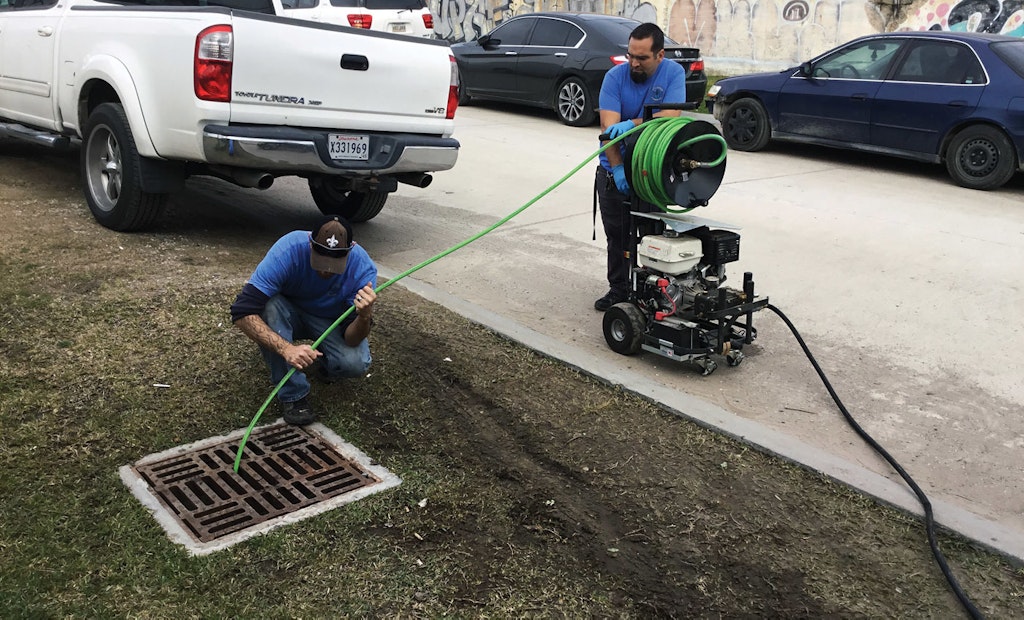
Pipe Wizard Plumbing technician Chris Engeron (left) and manager Mike Burke clean out a clogged subsurface yard drain with a M30 MaxBlast portable water jetter made by MyTana Mfg.
Interested in Cleaning?
Get Cleaning articles, news and videos right in your inbox! Sign up now.
Cleaning + Get AlertsDuring his couple decades of drain cleaning work, Tommy Surcouf, owner of Pipe Wizard Plumbing in New Orleans, has seen it all, from severely clogged yard drains to PVC pipes blocked with grease “logs” to commercial sewer lines jammed with thick, black muck.
There’s one thing he’s never seen, however: His M30 MaxBlast portable jetter fail to get the job done.
Made by MyTana Mfg., the MaxBlast features a vertical, upright design. The smaller footprint makes it easier to store on service vehicles, as well as wheel around and use. A removable hose reel comes in handy for buildings with limited access, says Surcouf, who started his company in 1996. The firm employs six people and mostly does residential service and repairs and drain cleaning.
“I’m telling you from personal experience that I’ve tried other brands of portable jetters, and for what we do, MyTana is by far the best,” Surcouf says. “It outlasts them all, with the least amount of maintenance. Durability is important to me because if a water pump goes down on a job, that’s it — you’re done. You can’t afford to buy equipment that messes things up right when you need them the most.”
Surcouf bought his first MaxBlast in 2004 after watching a demo at the Pumper & Cleaner Environmental Expo (now the Water & Wastewater Equipment, Treatment & Transport Show, or WWETT Show), and it’s still a company mainstay. Designed to clean lines from 1 1/2 to 6 inches in diameter, the machine measures 21 inches wide, 32 inches long, and 48 inches tall, and it weighs about 240 pounds.
The MaxBlast features a 13 hp Honda gasoline engine; a water pump that generates pressure and flow of 3,000 psi and up to 4 1/2 gpm; 75 feet of 1/8-inch-diameter hose and 200 feet of 3/8-inch-diameter hose; a pulse feature for working nozzles around tight pipe bends; and a thermal regulator that prevents the water pump from overheating. The unit also comes with six different nozzle tips and a 50-foot jumper hose.
One of the unit’s most impressive attributes is its durability. During Hurricane Katrina in August 2005, Surcouf’s shop was submerged under 8 feet of water for about two weeks. Amazingly enough, after removing the electric-start components, installing a new battery, flushing the fluids and giving the unit a thorough cleaning, it started right up.
“It looks like it went through a war, but it still runs fine,” Surcouf reports. “The only thing that changed is we didn’t replace the electric starter, so now we just pull-start it.”
Surcouf also likes the unit’s compact design, which makes it easier to load and unload and takes up minimal space inside his Ford service trucks.
Sometimes Surcouf and his technicians don’t even have to take the MaxBlast off a service truck to work, thanks to the removable hose reel. They just hook up one end of the jumper hose to the unit and the other end to the hose reel, then put the reel on a handy portable carrier that also serves as a stand. The technician takes only the reel inside a building — no need to awkwardly maneuver the entire machine down and up stairways or around tight spaces, he says.
“We prefer to use two people on drain cleaning jobs,” Surcouf explains. “But sometimes we can’t. That’s when the removable real comes in handy — one guy can carry the reel right to a clean-out and get to work.”
The MaxBlast handles all kinds of jobs, from scouring ingoing and outgoing grease trap lines to cleaning out yard drains clogged with leaves, pollen buildup and other accumulated debris. (Because New Orleans is below sea level, residential yards often include drainlines.) “If grease trap lines are completely stopped up with grease, those jobs might rate as an eight or a 10 on a scale of one to 10,” Surcouf notes. “Picture a 4-inch-diameter PVC pipe totally clogged by a solid, white grease log.”
The MaxBlast also is an endurance beast, Surcouf says. As an example, he cites occasional jobs where the unit runs eight hours a day for two or three days at a time while working through a few hundred feet of what he calls “muck” in commercial cast iron pipelines: a thick, black substance with the consistency of oatmeal.
“When we run it that hard and for that long, we back off on the pressure a bit because we don’t want to overwork it,” he says. “But it holds up just fine.”
The MaxBlast is so critical to Surcouf’s business that he bought a second one about a year ago. “For the type of work we do, it’s a big part of our bloodline. When customers have a stoppage, it’s an emergency — especially if it’s a business that has to shut down. When they need us, we need to be there with equipment that works. We also own cable machines, but when we have to do jetting, the MaxBlasts are invaluable.
“They keep our sewer and drain division going. For the money, MyTanas are the best value on the market. They pay for themselves over and over again.”





